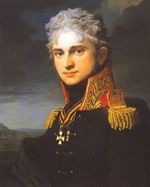Mike Lew
This winter, we're fighting back the cold with an old-timey classic, and we mean REALLY old-timey: beef stroganoff. This dish was invented sometime in the early 1800s and had its American heyday in the 1950s and 1960s, but since then has fallen out of favor (and flavor). We, however, aren't quite ready to send beef stroganoff off to pasture, because this dish can be so much more than the standard recipe of ground beef, onions, and cream of mushroom soup. For instance we've got one version that calls for tri-tip, Hungarian sweet paprika, and chanterelles. Another version calls for tenderloin, Cognac, and whipping cream.
But who was Stroganoff, exactly? A saint? A playboy? A tyrant?
As it turns out, the dish's namesake -- Count Pavel Aleksandrovich Stroganoff -- was kind of a hunk.
According to the Stroganoff Foundation, which is dedicated to "preserving the artistic legacy left to Russia by the Stroganoff family," the origins of the Stroganoff clan date back to just before the reign of Ivan the Terrible. In the 1300s, the family swelled its fortunes through trade, land acquisition, and salt mining. Then, as Ivan the Terrible sealed his control over Moscow and all its surrounding states, the Stroganoff family matriarch (Anika Feodorovitch, 1488-1570) made a daring gambit by seizing much of Siberia and allying herself with Ivan, ceding her territory to him in exchange for a long-term land grant. Effectively, this made the Stroganoff family the de facto manager of all of Siberia.
Flash-forward to the 17th century and the Stroganoffs were still closely aligned with the czarist government, and much wealthier for it. The family was now part of a Europe-hopping Russian aristocracy, which is why Count Pavel Stroganoff (1774-1817) was actually born in Paris. The son of Count Alexander Sergeyevich Stroganoff and Princess Ekaterina Troubetzkaya, Pavel is largely a footnote to Russian history. Despite being pretty low-key (as low-key as a ridiculously wealthy member of the Russian elite can be), he did serve as a diplomat to Britain and a general in the Napoleonic Wars (for which he earned the St. George Cross, one of Russia's highest military honors).
SEE MORE:Ingredients We Can't Cook Without
Count Stroganoff's French/Russian split found its way into his diet, as Russian aristocrats would often hire French cooks but retain a palate honed in the homeland. According to the cookbook A Taste of Russia, the original beef Stroganoff recipe derived from a basic French mustard for seasoning beef, combined with a dollop of Russian sour cream, which Stroganoff's chef named after his benefactor.
The count himself died of tuberculosis at the age of 43, somewhere near Copenhagen. His clan lived on in luxury well into the 19th century, and today they are survived by a vast art collection as well as a grand estate in St. Petersburg known as the Stroganoff Palace.
You can even visit the Stroganoff Palace if you so choose. It was nationalized in 1917 and became a part of the state's Russian Museum in 1990. Just don't arrive looking for any "authentic family recipe tips" from real Stroganoff family members. The last heiress to the Stroganoff dynasty, Countess Olga, died in 1837.
See more from Bon Appetit:
10 Snacks You Thought Were Healthy But Really Aren't
25 Ways to Use Sriracha
8 Foods That Could Kill You
21 Recipes for Dutch Ovens
